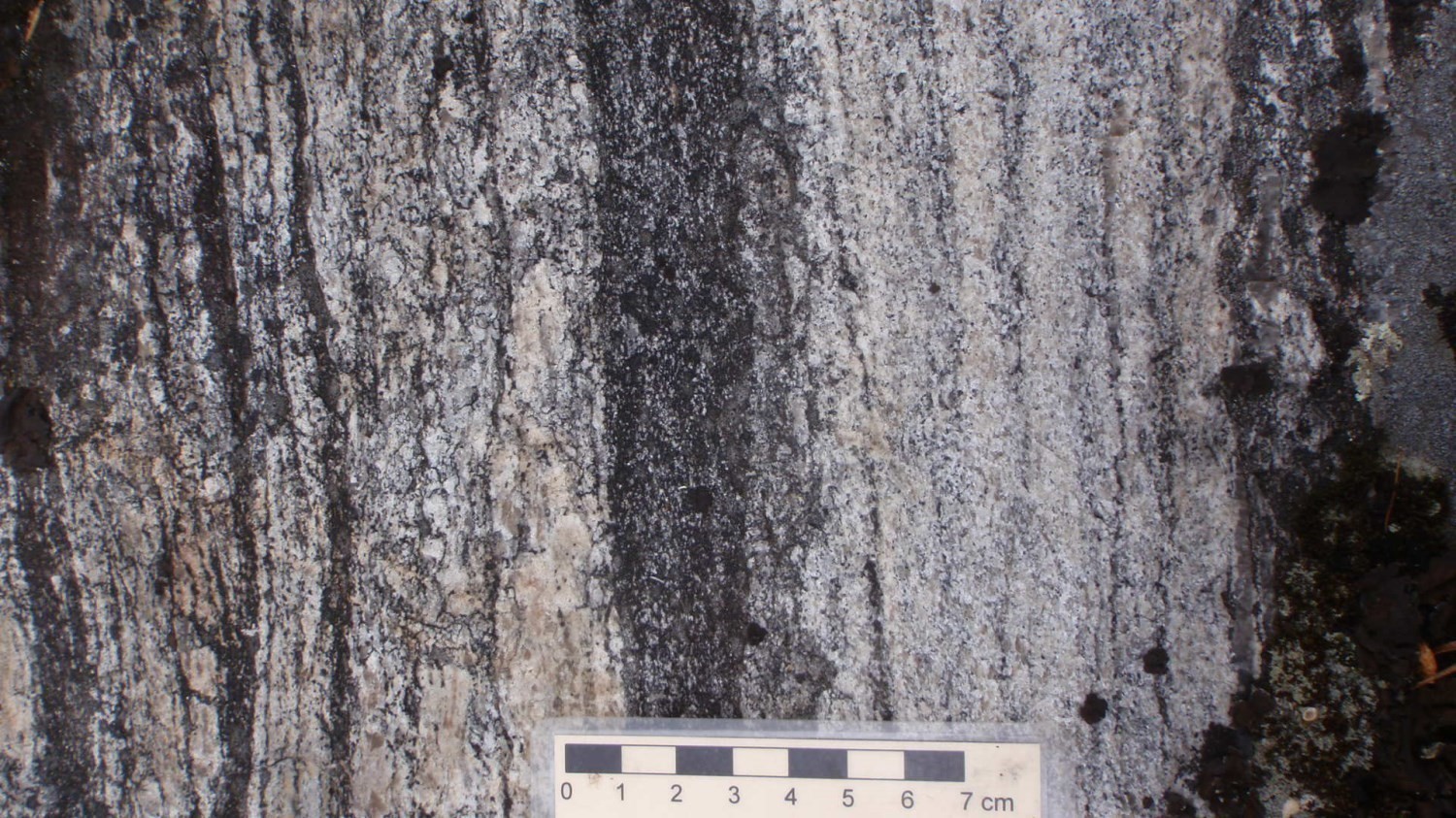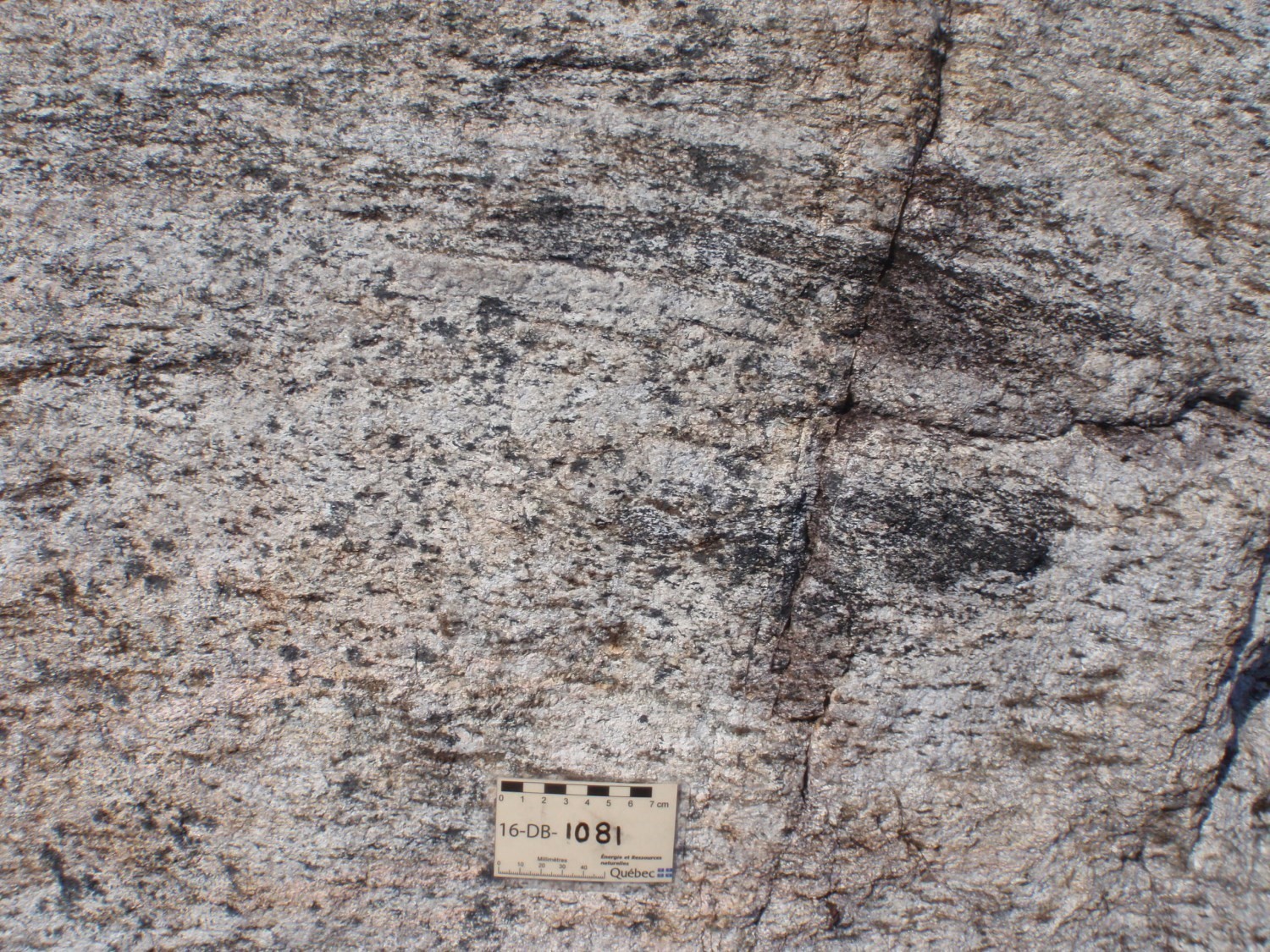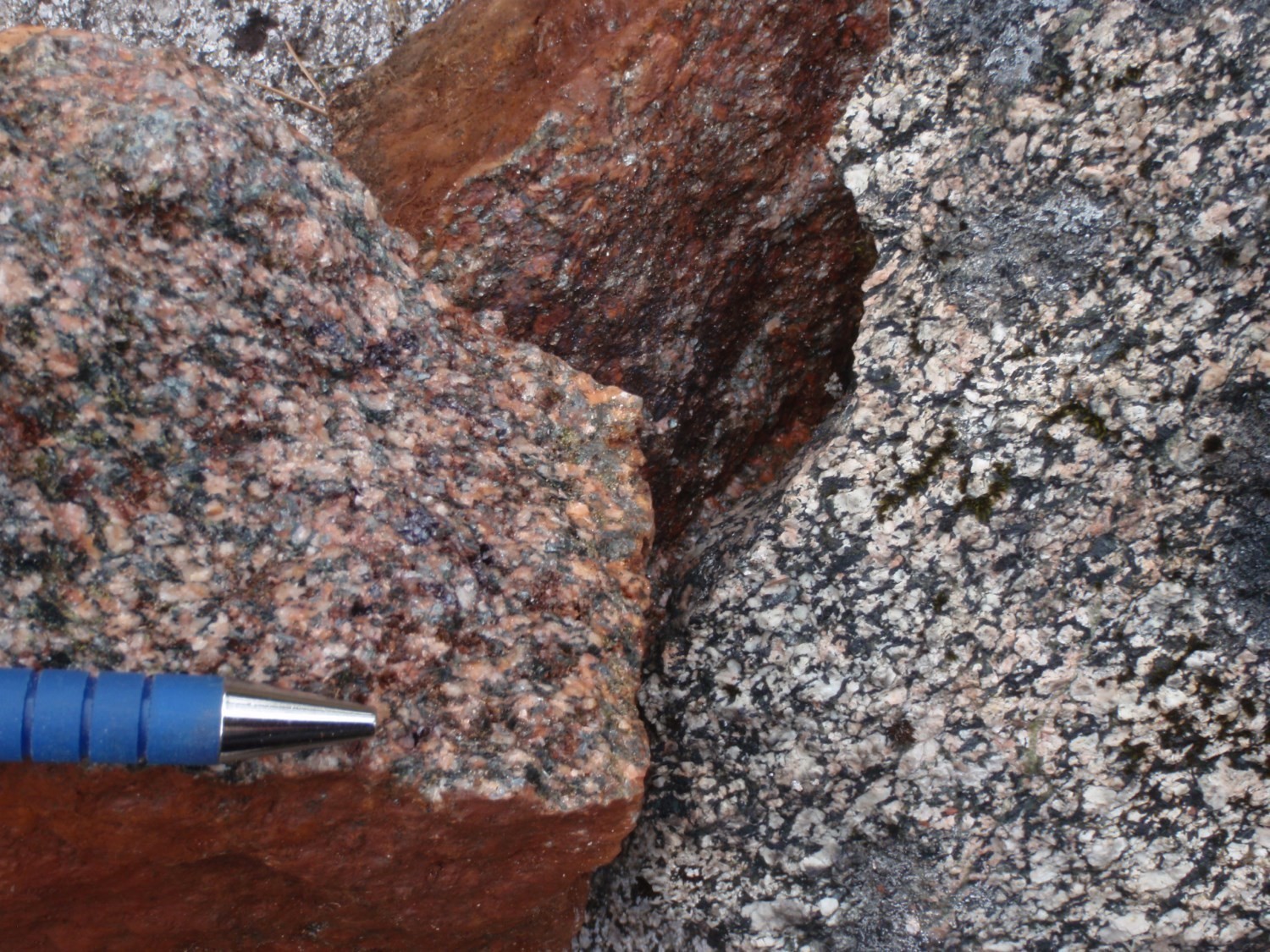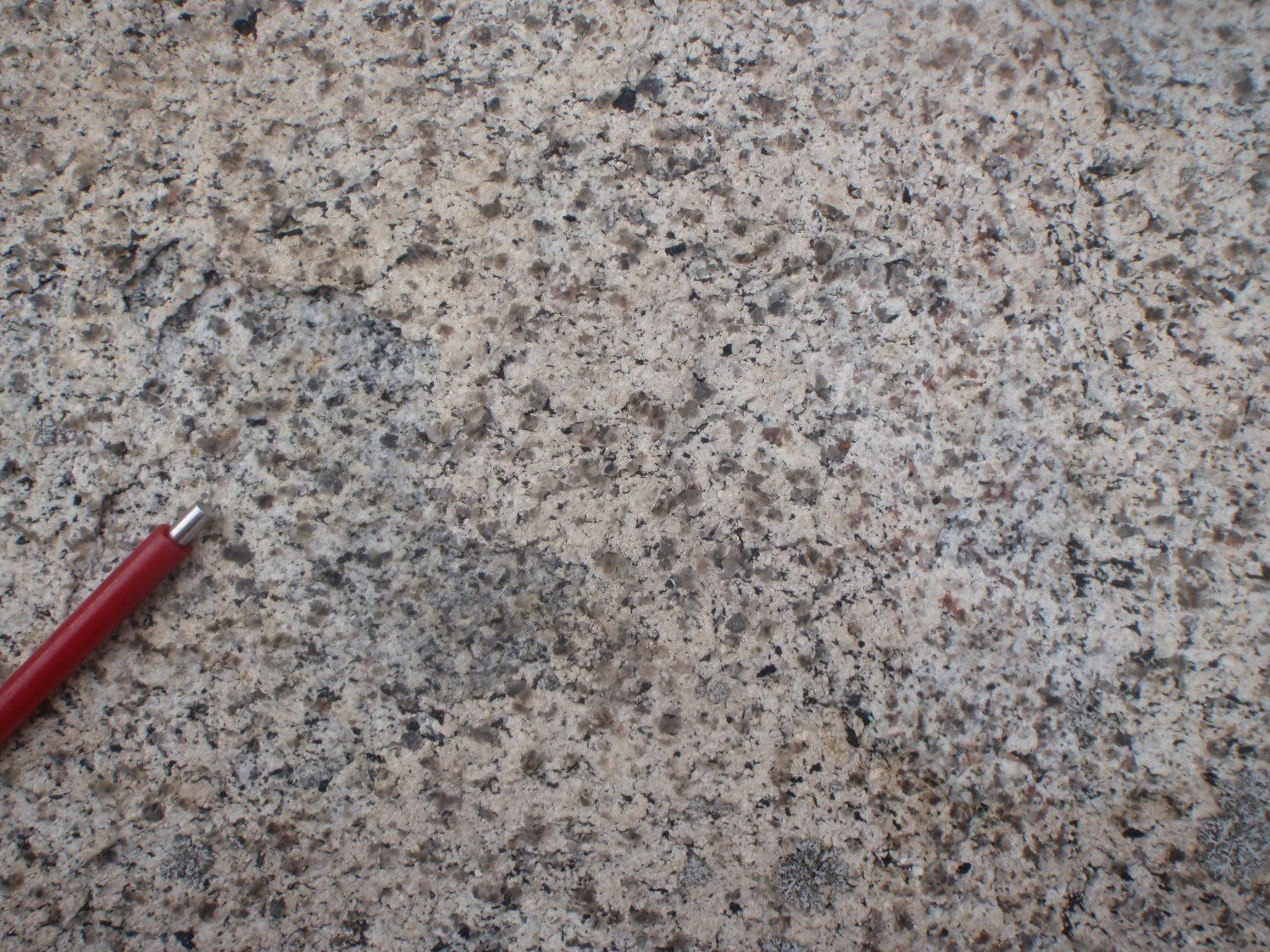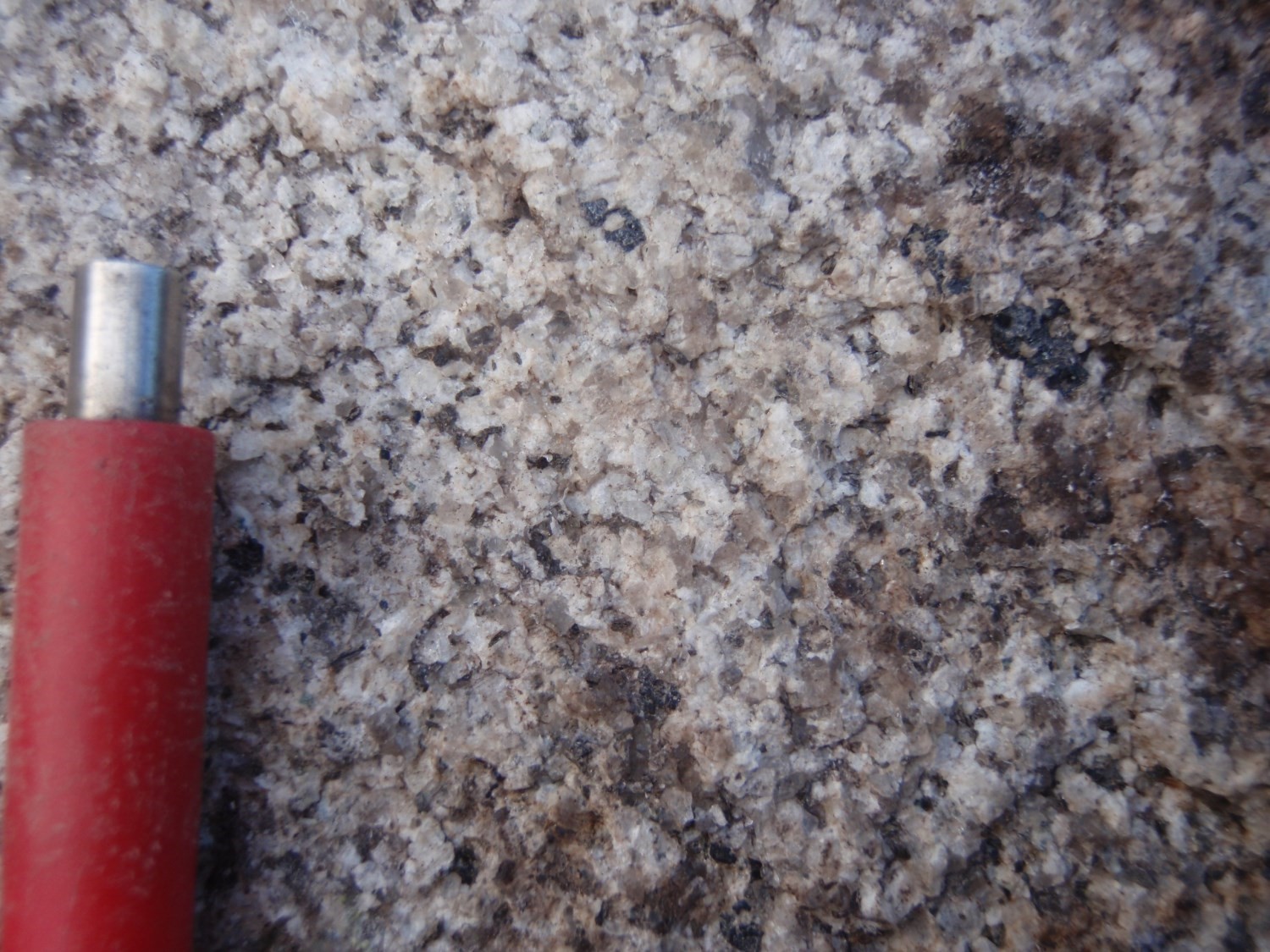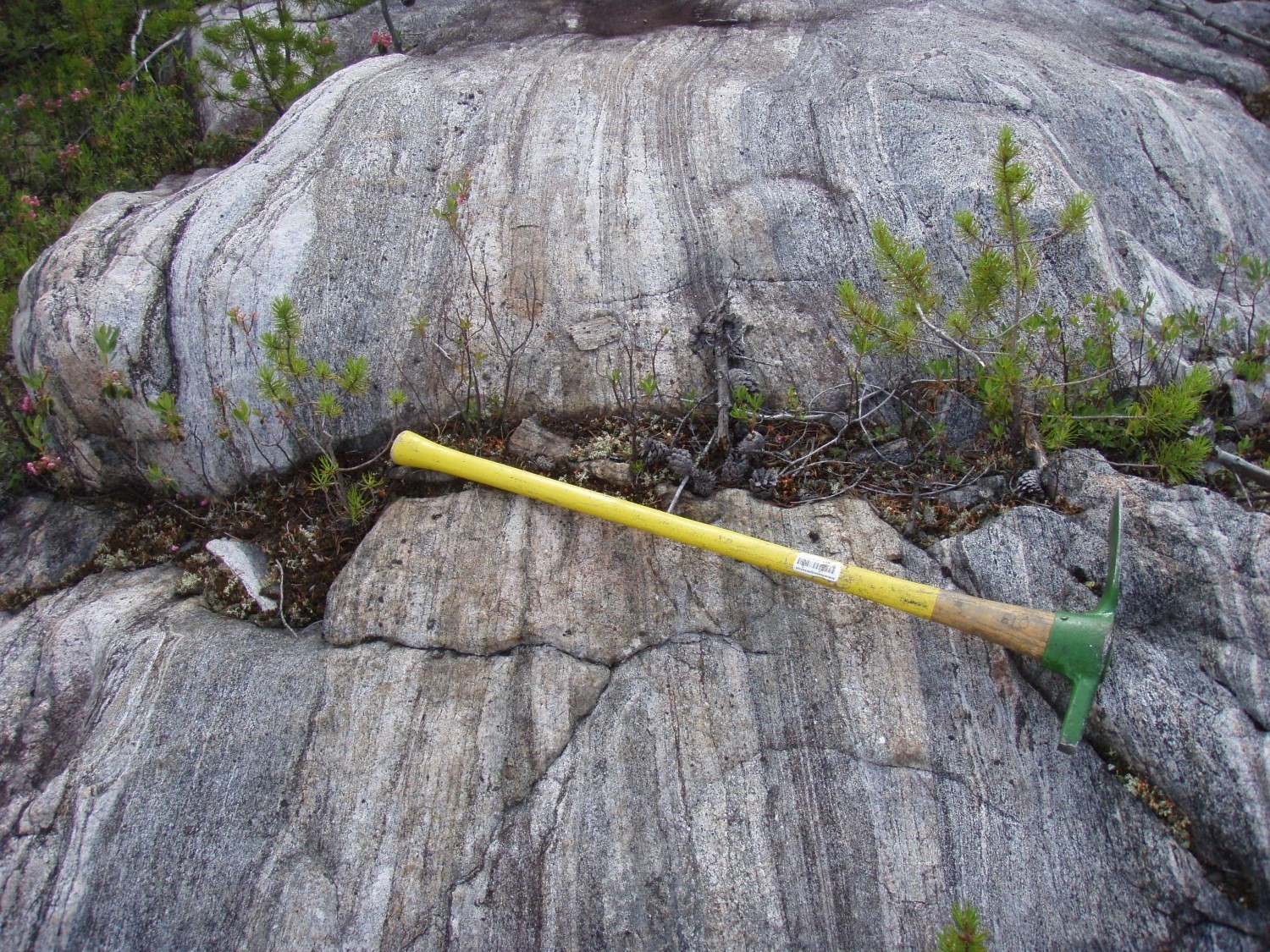
DISCLAIMER: This English version is translated from the original French. In case of any discrepancy, the French version shall prevail.
| Author(s): | Bandyayera and Daoudene, 2018a |
| Age: | Archean |
| Stratotype | None |
| Type area: | Boisrobert area (NTS sheet 32N11) |
| Geological province: | Superior Province |
| Geological subdivision: | La Grande Subprovince |
| Lithology: | Felsic intrusive rocks more or less foliated and migmatized |
| Category: | Lithodemic |
| Rank: | Complex |
| Status: | Formal |
| Use: | Active |
None
Background
The Champion Complex is introduced to describe a large, polyphase, intrusive mass bounded by the Eastmain Group to the north, by the Nemiscau metasedimentary Subprovince to the west and south, and by the Lac des Montagnes Group to the east. It encompasses the Champion Lake plutonic terrain first assigned by Card and Ciesielski (1986) to the La Grande Subprovince, then reassigned to the Nemiscau Subprovince by Hocq (1994). New geophysical and geological data (D’Amours, 2011; Moukhsil, 2000), as well as fieldwork results from 2016 (Bandyayera and Daoudene, 2018a), 2017 (Bandyayera and Daoudene, 2018b), 2018 (Bandyayera and Caron-Côté, 2019) and 2021 (Bandyayera and Caron, 2022) indicate that the Champion Complex is the southern extension of the La Grande Subprovince.
Strips of tonalitic gneiss within the Nemiscau Subprovince, around Échancrure, Naquiperdu and Caumont lakes, had also been assigned to this unit by Bandyayera and Daoudene (2018a, b). Nevertheless, these bands were reassigned to the Hutte Complex to group gneissic, tonalitic and granodioritic bodies of the Nemiscau Subprovince (Bandyayera and Caron-Côté, 2019).
Description
The Champion Complex is a package of polyphase intrusive rocks hosted by tonalitic gneiss. It consists of six units: 1) a tonalitic gneiss unit (Achp1); 2) a unit of pyroxene-hornblende tonalite and granodiorite (Achp2); 3) a quartz diorite unit (Achp3); 4) a granodiorite unit (Achp4); 5) a porphyritic granodiorite unit (Achp5); and 6) a package of granodiorite and granite containing migmatite and tonalitic or granodioritic gneiss enclaves (Achp6).
Champion Complex 1 (Achp1): Tonalitic Gneiss Locally Granitic
Unit Achp1, outcropping NW of Mezières Lake (sheet 33N06), is separated from the Lac des Montagnes Group by the Rivière Rupert Shear Zone (RRSZ). Tonalitic gneiss is medium grained, light grey in altered surface and fresh exposure. It is heavily deformed, folded, locally banded, heterogeneous and low to highly magnetic. The gneissic texture is primarily marked by alternating millimetric to centimetric white and greyish ribbons. This banding is locally accentuated by centimetric intrusions of pink granite or granodiorite parallel to foliation planes. It is more pronounced near deformation zones. Fine to medium-grained tonalitic to dioritic ribbons are partially recrystallized. They contain 10 to 20% greenish hornblende and brownish to greenish-brown biotite in varying proportions. Biotite is chloritized and commonly contains zircon inclusions. Accessory minerals are allanite, sphene and apatite. South of the Mezières Lake area (sheet 32N06), the tonalitic gneiss that appears within the migmatites is highly magnetic and includes up to 10% magnetite. Unit Achp1 includes up to 20% enclaves or decametric strips of foliated and locally gneissic magnetic diorite. From a geochemical perspective, tonalitic gneiss are metaluminous to locally peraluminous, type I, typically calcic and moderately enriched with potassium.
Champion Complex 2 (Achp2): Tonalite, Pyroxene-Hornblende Granodiorite
Unit Achp2 consists of tonalite and granodiorite in lesser proportions. Tonalite contains biotite (10%), hornblende (5%), magnetite (3%), and, in smaller proportions, epidote, sphene and apatite. The rock is medium-grained and locally hematitized. It is homogeneous or weakly foliated in appearance and has a granoblastic and equigranular texture. It is pale grey or pinkish white in altered surface and beige in fresh exposure. Unit Achp2 also contains bands of granodiorite that are difficult to distinguish from tonalite in outcrop. The latter also contains up to 10% medium-grained and granoblastic diorite enclaves characterized by a dark-grey alteration patina. Enclaves are flattened and elongated parallel to foliation planes.
Champion Complex 3 (Achp3): Diorite and Quartz Diorite
Unit Achp3 is best exposed NE of the Lake Boisrobert area (sheet 32N11), close to the contact between the Champion Complex and the Anatacau-Pivert Formation. It consists of biotite-rich intermediate rocks that vary in composition from diorite to quartz diorite. These diorites are medium grained and homogeneous, weakly to strongly foliated and granoblastic. They are light grey in altered surface and beige in fresh exposure. The rock typically contains 40-60% of mafic minerals (hornblende and biotite) and 2% of magnetite. From a geochemical perspective, diorites and quartz diorites of unit Achp3 are metaluminous, of calc-alkaline affinity and characterized by the absence of europium anomaly.
Champion Complex 3a (Achp3a): Monzodiorite and Quartz Monzodiorite
Subunit Achp3a is better exposed NE of Amikap Lake (sheet 32N11), following unit Achp3. It was created to describe a group of monzodiorite and quartz monzonite, generally foliated, locally massive, homogeneous and medium to coarse grained. These intermediate rocks are characterized by the presence of 20% disseminated euhedral to subhedral phenocrystals of plagioclase or K-feldspar, 0.5 to 1 cm (longest axis). The rock is white to slightly pinkish in altered surface and beige to pinkish grey in fresh exposure. The pinkish colour is due to hematization. The rock is weakly to strongly hematitized and contains chloritized hornblende (10-30%), biotite (5-15%), chlorite (1-10%), epidote disseminated or in veinlets (10%), and accessory apatite and allanite. Monzodiorite of subunit Achp3a also centimetric to metric enclaves of unit Achp3 fine-grained diorite, rich in mafic minerals (>55%), stretched parallel to foliation planes and partially assimilated.
Champion Complex 4 (Achp4): Granodiorite
Unit Achp4 outcrops on the southern edge of the Champion Complex, between Nemiscau Lake and the Jolliet River (sheets 32N06 and 32N07). It is also observed in the Champion Lake area (32N09), north of the Nemiscau and Caumont lakes. Unit Achp4 is separated from the Lac des Montagnes Group by the RRSZ. On aeromagnetic maps, it is distinguished from the surrounding rocks by low magnetic susceptibility. This unit consists of medium-grained, homogeneous, weakly to strongly foliated granodiorite. Petrographic and geochemical analyses show that locally, unit Achp4 consists of tonalite. However, to the naked eye, these two rocks are very similar. The rock is light grey in altered surface, locally pinkish, and light grey in fresh exposure. It generally contains 10% biotite, 2-10% hornblende and 1-2% magnetite. The foliated rocks are also the richest in mafic minerals (hornblende and biotite) with contents of up to 20%. Unit Achp4 contains up to 10% centimetric to metric amphibolite and quartz diorite enclaves that contain up to 50% of hornblende. Geochemical analyses show that these rocks are the type I, bordering metaluminous and pareluminous, of calc-alkaline affinity and depleted to moderately enriched in potassium.
Champion Complex 5 (Achp5): Porphyritic Granodiorite
Unit Achp5 is located in the heart of the Champion Complex. It consists of granodiorite characterized by a porphyraceous texture linked to the presence of 1-2 cm long euhedral to subrounded K-feldspar phenocrystals. The proportion of phenocrystals varies from 2 to 20%, but is on average around 10%. In places, K-feldspar (orthose) phenocrystals have whitish plagioclase rims, giving the rock a rapakivi texture. Massive to weakly-foliated granodiorite is homogeneous, medium grained and usually magnetic. It is pinkish grey in fresh exposure and altered surface. Locally, a weak foliation is highlighted by the alignment of K-feldspar phenocrystals; it likely represents magmatic foliation associated with intrusion of the granodiorite. The rock contains less than 15% mafic minerals including partially chloritized biotite (10-15%) and hornblende (1-10%). Sphene, allanite and magnetite are the most common accessory minerals.
In places, outcrops assigned to unit Achp5 contain up to 30% of granite in diffuse or transitional contact with granodiorite. Unit Achp5 also contains metric to decametric enclaves of tonalite, amphibolite or diorite.
Champion Complex 6 (Achp6): Granodiorite and Granite Containing Migmatite and Tonalitic or Granodioritic Gneiss Enclaves
Unit Achp6 outcrops northeast of the Lake Boisrobert region (sheet 32N11), in contact with the Northern Anatacau-Pivert Formation and the Rupert Complex in the west and south. It consists of a package of granodiorite and granite characterized by a significant amount of migmatite and tonalitic or granodioritic gneiss enclaves. These enclaves generally show a very high degree of assimilation and form ribbons that resemble schlierens.
Granodiorite and granite are very heterogeneous lithologies, with a heterogranular and foliated texture, locally gneissic. These magnetic and hematitized rocks are brownish beige in altered surface and light grey in fresh exposure. They contain strongly chloritized biotite schlierens, hornblende and magnetite. Migmatite enclaves, consisting of migmatized paragneiss, metatexite and diatexite, are folded and stretched in foliation planes. The northern part of this unit, located in contact with the Anatacau-pivert Formation, is composed mainly of a homogeneous, massive to weakly foliated, pink granodiorite. Finally, this area is an area of high magnetic susceptibility.
Thickness and Distribution
The Champion Complex is the southern extension of the La Grande Subprovince. New geophysical and geological data show that this unit extends NE over a distance of 200 km and a width of 65 km. In the west end of the Rupert River, granitic and granodioritic rocks account for 80% of the Champion Complex. The oldest rocks in the Champion Complex are tonalitic gneiss, which are ~8 km wide and 20 km long.
Dating
During the work of Bandyayera and Daoudene (2018a) in the Nemiscau Lake area, a sample of gneiss belonging to the Champion Complex (Achp1) was taken from outcrop 2016-CS-4003, 8 km to the NW of Mézière Lake. This sample of tonalitic gneiss gave an age of 2815,8 ±3 Ma (David, 2020). Another sample also belonging to unit Achp1 was dated by Bynoe (2014). This granitic gneiss is located 1 km to the NE of the Spodumène Lake; it returned an age of 2889 ±14 Ma. These Mesoarchean ages are consistent with the hypothesis that Champion Complex gneiss are bedrocks and among the oldest in the region.
| Unit | Sample | Isotopic System | Mineral | Crystallization Age (Ma) | (+) | (-) | Reference(s) |
| Achp1 | 2016-CS-4003B1 | U-Pb | Zircon | 2815,8 | 3 | 3 | David, 2020 |
| – | U-Pb | Monazite | 2889 | 14 | 14 | Bynoe, 2014 |
Stratigraphic Relationship(s)
The Champion Complex is one of the oldest units in the Rupert River area. It forms the host unit of the majority of intrusive units in the region and is located in enclaves in these same units. In the south, the Champion Complex is separated from the Rupert Complex by the Rivière Rupert Shear Zone (ZCrup), and from the Lac des Montagnes Group by the Nisk Shear Zone (ZCnsk). The various units of the Champion Complex are cut by pink granite and granitic pegmatite intrusions assigned to the Kaupanaukau Suite.
Paleontology
Does not apply.
References
Publications Available Through SIGÉOM Examine
BANDYAYERA, D., CARON-CÔTÉ, E., 2019. Géologie de la région du lac des Montagnes, sous-provinces de La Grande, de Nemiscau et d’Opatica, Eeyou Istchee Baie-James, Québec, Canada. MERN; BG 2019-03, 1 plan.
BANDYAYERA, D., CARON-CÔTÉ, E., 2022. Géologie de la région du lac Le Vilin, sous-provinces de La Grande et d’Opatica, Eeyou Istchee Baie-James, Québec, Canada. MERN; BG 2022-03, 1 plan.
BANDYAYERA, D., DAOUDENE, Y., 2016. Géologie-région du lac Nemiscau, secteur ouest de la rivière Rupert. MERN; CG-2016-02, 1 plan.
BANDYAYERA, D., DAOUDENE, Y., 2018a. Géologie de la région du lac Nemiscau, secteur ouest de la rivière Rupert (SNRC 32N06, 32N07 et 32N11). MERN; RG 2018-03, 58 pages, 1 plan.
BANDYAYERA, D., DAOUDENE, Y., 2018b. Géologie de la région du lac Champion, sous-provinces de La Grande et de Nemiscau, à l’est de Waskaganish, Eeyou Istchee Baie-James, Québec, Canada. MERN; BG 2018-06, 2 plans.
D’AMOURS, I., 2011. Synthèse des levés magnétiques de la Baie-James. MRNF; DP 2011-08, 5 pages, 2 plans.
DAVID, J., 2020. Datations U-Pb dans les provinces du Supérieur et de Churchill effectuées au GEOTOP en 2017-2018. MERN, GEOTOP; MB 2020-05, 29 pages.
HOCQ, M., VERPAELST, P., CLARK, T., LAMOTHE, D., BRISEBOIS, D., BRUN, J., MARTINEAU, G., 1994. GEOLOGIE DU QUEBEC. MRN; MM 94-01, 172 pages.
MOUKHSIL, A., 2000. Géologie de la région des lacs Pivert, Anatacau, Kauputauchechun et Wapamisk, 33C/01, 33C/02, 33C/07 et 33C/08. MRN; RG 2000-04, 49 pages, 4 plans.
Other Publications
CARD, K.D., CIESIELSKI, A., 1986. DNAG N° 1. Subdivisions of the Superior Province of the Canadian Shield. Geosciences Canada; volume 13, pages 5-13. https://journals.lib.unb.ca/index.php/GC/issue/view/370
BYNOE, L., 2014. Shear zone influence on the emplacement of a giant pegmatite: The Whabouchi lithium pegmatite, Québec, Canada. University of Western Ontario, London, Ontario, Canada; Mémoire de maîtrise, 136 pages. https://ir.lib.uwo.ca/etd/1987
PEARCE, T.H., HARRIS, B.W., TINDLE, A.G., 1984. Trace element discrimination diagrams for the tectonic interpretation of granitic rocks. Journal of Geology; volume 25, pages 956-983. https://doi.org/10.1093/petrology/25.4.956
Suggested Citation
Contributors
|
First publication |
Daniel Bandyayera, P. Geo., Ph.D. daniel.bandyayera@mern.gouv.qc.ca (redaction) Mehdi A. Guemache, P. Geo., Ph.D. (coordination); Jean Goutier, P. Geo., M.Sc. (critical review); Claude Dion, Eng., M.Sc. (editing); Céline Dupuis, P. Geo., Ph.D. (English version); Caroline Thorn (HTML edtiting). |


